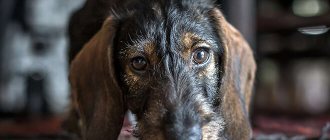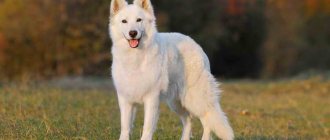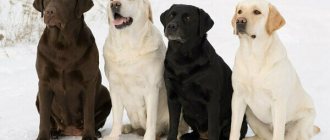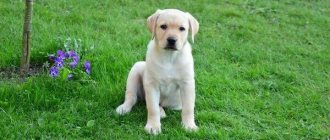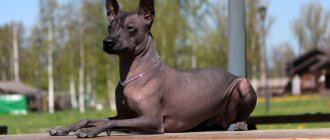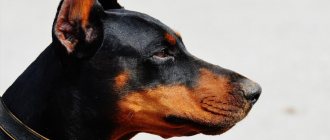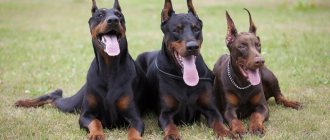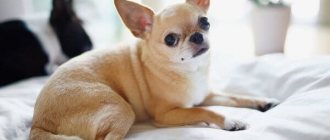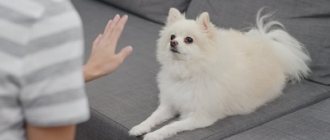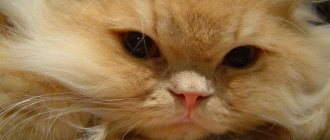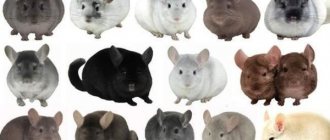Persecution of albino people
Various rumors have long been spread about people with this pathology. Against the background of superstitions, warlocks hunted for them, wanting to get a part of the body supposedly endowed with special powers. Other people, on the contrary, considered albinos almost as healing gods who could eliminate human troubles. According to rumors, in Tanzania on the black market the price of an albino limb can reach 75 thousand dollars. In the media and culture, the topic of albinism is often ridiculed or people are portrayed as socially dangerous, inferior, or underdeveloped.
A modern person, having knowledge about albinism, can try to provide support to people, help them adapt to society, and organize jobs. Be more humane towards your neighbor.
Price range
The price for Doberman puppies in nurseries can reach up to 60,000 rubles . In private advertisements you can find a price of 15,000 rubles. This applies to the cost of dogs of regular color.
For a white Doberman, the price can be doubled.
Before purchasing an unusual puppy, you should think more than once about the fact that exoticism and originality will be accompanied by the pet’s poor health due to genetic problems, unpredictability of behavior, excessive nervousness and cowardice.
Diagnostics
The diagnosis is based on the patient’s complaint of seeing double. The following studies are carried out as diagnostic procedures:
- ophthalmoscopy;
- visometry;
- examination of the conjunctiva, color perception, visual acuity;
- special cover test - will help assess the mobility and position of the eyelids;
- hardware studies - MRI, CT, ultrasound;
- consultation with specialized specialists (psychiatrist, oncologist, neurologist, endocrinologist, neuro-ophthalmologist, dermatovenerologist) if necessary.
To identify the damaged eye muscle, coordimetry is used. The study is carried out using an ophthalmocoordimeter - the procedure is a kind of test vision control. The patient must continuously look at the moving light source, then the image is transferred to the coordinate map.
Character traits
White Dobermans are very different from their well-pigmented relatives. Very often they have problems with mental instability. Often such puppies grow into nervous, timid, cowardly and unpredictable dogs, unsuitable for use as guards.
However, it cannot be said with absolute certainty that such behavior is directly related to color. Indeed, even among white Dobermans, sometimes there are worthy representatives of the breed, possessing all its inherent qualities. All these animals have highly developed possessive instincts. They require constant attention and do not tolerate being relegated to the background. These dogs feel like full-fledged members of their owner’s family and are ready to zealously protect them from intruders.
When it comes to learning, it requires determination and perseverance. At the same time, it is important not to allow yourself to be rude and cruel towards the dog. The owner must demonstrate to the dog who is in charge, without yelling or assaulting him. Otherwise, instead of a loyal friend, the puppy may grow into an aggressive and uncontrollable animal.
You might be interested
Lancashire Heeler. Description of the breed. Story. Care
The Lancashire Heeler is a versatile herding dog breed, small and stocky, with a strong build. Externally – …read more
Schnauzer - everything about the breed. Maintenance and care
Schnauzer, service dog, bodyguard dog, which must be constantly close to the owner - in the car, on ...read more
The Mongolian Shepherd - Banhar - is one of the few dogs on Earth that descended from a wolf, and ...read more
Miniature Bull Terrier. Care. Health.
The miniature bull terrier, as an independent breed of dog, appeared at the beginning of the 19th century, when there were ...read more
Description
The white Doberman Pinscher is a partial or incomplete albino with blue eyes. Selection work on breeding this species began in the mid-19th century, the goal of which was to obtain hardy, intelligent and disciplined dogs for police work. The first puppies were obtained only two decades later from parents of a standard color. Inbreeding did not bring a fixed result, but only a partial one.
The appearance of such an unusual color is due to the fact that the gene responsible for the white color of the animal’s coat is not located together with the diluting and color genes, but in a different place in the chromosome. And the two above-mentioned DNA sections are precisely responsible for the formation of one of the main four colors of Dobermans.
This breed is not an officially recognized species, and puppies born are discarded due to the presence of genetic defects, injuries and very poor health. Dog handlers pay special attention to fear and intolerance to light.
The white Doberman is a strong and at the same time elegant animal with a developed muscular system and a protruding chest. The skull has a triangular elongated shape, with small oval eyeballs located on it. Protruding ears can be either cropped or intact. The jaw has a scissor bite and strong white teeth.
The long and strong neck smoothly transitions into a small back. In all newborn puppies, breeders almost completely dock the tail immediately after birth. The muscular limbs are long and parallel. The average height of an adult is 75 cm and weight is 50 kg .
The average life expectancy of a white Doberman is 7 years, but by creating comfortable living conditions, choosing the right menu and balancing physical activity, the animal will be able to please its owners for more than 10 years.
The white coat consists of short and coarse hair without undercoat. Features of albinos are the presence of blue eyes and a light-colored nose. These individuals are not used for breeding, and also do not participate in exhibitions and competitions.
Distinctive character traits:
- indecision;
- lack of quick response;
- cowardice;
- inadequacy;
- nervousness;
- developed sense of ownership;
- devotion.
These character traits must be taken into account during training and training of animals. The Doberman must constantly feel the attention of its owner and understand his superiority. The animal will only obey commands from a strong and persistent owner. All demands must be stated firmly and confidently, but without aggression, cruelty, beatings or rudeness. After a correctly completed task, it is advisable to reward your pet with a tasty treat.
The genetic makeup of white Dobermans makes them vulnerable to the following diseases:
- fear of light;
- chronic eye and hearing diseases;
- oncology and various types of tumors;
- diseases of the endocrine system;
- lipoma;
- diseases of the digestive system;
- hepatitis;
- allergy;
- hair loss;
- von Willebrand disease;
- diseases of the circulatory system;
- diseases of the musculoskeletal system and joints;
- skin rashes and irritations.
Like any pet, the white Doberman has a number of advantages and disadvantages.
Advantages:
- beautiful appearance;
- devotion.
Flaws:
- high susceptibility to various diseases;
- weak nervous system;
- poor perception of commands.
History of the Doberman breed
Doberman
Karl Friedrich Louis Dobermann is the full name of the man who became the creator of the dog breed that is so popular in our time. A native of the small German town of Alpoda, he changed many professions, including a tax collector and a night policeman. It was during this period that Karl began to think about breeding a breed that would best meet his job requirements. According to Dobermann, such a dog should have been of medium height, smooth-haired, harmoniously combining intellectual qualities with vigilance and physical endurance. Constantly visiting animal exhibitions and sales, which began to be regularly held in Apolda since 1860, he selected the most suitable animals for breeding work.
In 1880, Dobermann and his friends bought a small house and began to work closely on breeding a new breed. Soon the first success came. Dobermann dogs were purchased with pleasure by numerous clients. Today it is difficult to establish which breeds were used in breeding, since no records were kept about the progress and results of selection. It can be assumed that among the Doberman's ancestors there were Old German pinschers, Bosserone shepherd dogs, and Rottweilers. It is possible that the Manchester black and tan terrier, blue dane, pointer and even mastiff could have left their mark. The main thing remains that the result was a dog with surprisingly diverse and pronounced characteristics.
The breed was originally called the Thuringian Pinscher. Another resident of Apolda named Otto Goeller (Holler) began to seriously improve it. He managed to somewhat soften the dog’s overly aggressive character, making it more docile and obedient, without sacrificing at all his amazing abilities for security and guard service.
Doberman puppy
The story with the Dobermans was not without its oddities. Goeller's neighbor so actively expressed his dissatisfaction with the noise and barking constantly coming from Otto's house that the latter was forced to give away most of the dogs, leaving only a few representatives of the new breed. This gave an additional impetus to its spread and contributed to the growth of popularity.
In 1894, after the death of Karl Dobermann, in memory of his services, the breed was renamed the Dobermann Pinscher. In 1897, a special display was organized in Erfurt, Germany, and an official presentation took place. In 1899, the “Apolda Doberman Pinscher of the Year” club was created, and just a year later, due to the huge increase in the popularity of the animals, it was renamed the “National Doberman Pinscher Club of Germany”. The breed began its triumphal march across Europe, and then throughout the world.
In Russia, Dobermans became widespread at the very beginning of the 20th century.
In 1949, the second word was removed from the name of the breed, since leading dog handlers considered it incorrect to classify this dog as a pinscher.
In February 1994, the Fédération Cynologique Internationale (FCI) listed the Doberman breed in its register under No. 143, indicating Germany as its country of origin.
History of the breed
The breed was developed by the German tax collector Friedrich Louis Dobermann at the end of the 19th century.
Friedrich's position was fraught with danger, and he needed an aggressive dog that could protect him, but at the same time did not require special care. Dobermann was the owner of a shelter for homeless dogs, so it was not difficult for him to realize his plans. Having crossed dog breeds characterized by aggressiveness, endurance and high watchdog qualities - German pinscher, Rottweiler, Manchester terrier and pointer, Dobermann in a short time developed the type of dog he needed. Subsequently, the bred breed was named after its owner and became known as the Doberman.
Breed characteristics
The original name of the breed is Thuringian Pinscher. By the name of the federal state in Germany where it was bred. Later - Doberman Pinscher. Today these names are not used as they are outdated. The breed received its modern name from the surname of the first breeder.
FCI breed standard: No. 143
For Dobermans, the breed standard presupposes a strong and hardy animal, with a slender build, proud posture, smooth short hair and good working characteristics. Interestingly, the standard has changed quite a bit over time. Initially, these dogs had many of the features of the muscular and heavier Rottweilers. But aesthetic preferences changed, and gradually they received that elegant, recognizable look that we know
At the same time, increased attention has always been paid to the intelligence of animals
Size, weight and height of the breed
The Doberman can be considered the physical standard of a dog of normal build. Medium in size, slender, with pronounced, well-defined muscles, a proud carriage of the head on a high neck. These animals, with their entire appearance, express excellent physical fitness, swiftness and vigilance.
The standard assumes a height at the withers for males from 68 to 72 cm, for girls - from 63 to 68. At the same time, the weight is 40-45 and about 32-35 for males and females, respectively. Average build.
Possible colors
Initially, Dobermans were supposed to have only one color – black and tan. But today the standard includes four color varieties.
Standard Doberman colors:
- Black and tan
- Brown and tan
- Blue Doberman with tan
- Isabella (brownish yellow)
Variations such as: albino Doberman (white Doberman) are also possible.
Puppy weight by month
Puppies grow quickly. By the end of the month, the boy’s weight almost reaches four kilograms.
- at 2 months – 8.7 kg.
- at 3 months – 14 kg.
- at 4 months – 18.5 kg.
- at 5 months – 22.5 kg.
- at 6 months – 26 kg.
- at 7 months – 27.8 kg.
- at 8 months – 29.5 kg.
- at 9 months – 31.2 kg.
- at 10 months – 33 kg.
- at 11 months – 34 kg.
- One-year-old Dobermans gain 35 kg.
Bitches are more petite. By the first month, their weight should be 3.5 kg. Subsequently, they grow a little slower than boys, and a one-year-old dog weighs about 29-30 kg.
Lifespan
Most representatives of this breed live in good conditions for 12 years, long-livers - 15. But much depends on the pet’s heredity and living conditions.
There is an opinion that all Dobermans suffer from cardiovascular diseases and do not live longer than 8-9 years. This is absolutely not true. Proper feeding, good care and normal physical activity are the best prevention of any diseases and guarantee a long life for your pet.
Allergenicity
For allergy sufferers, he is no more dangerous than other pets. These animals are short-haired, which, however, does not mean they are completely “hypoallergenic”. They shed just like everyone else. Regular combing and trimming several times a year will solve the problem.
Distinctive features of the breed
The Doberman breed stands out for its elegant and proud appearance. This is a fearless, muscular and intelligent dog - qualities that allow the Doberman to be used as a guard and watchman. A developed sense of smell contributes to the fact that the Doberman is considered an unrivaled bloodhound. The dog becomes strongly attached to the owner and members of his family, does not trust strangers, and is moderately aggressive. If these qualities are developed through training, then the Doberman will become an excellent guide dog.
What is the albinism gene
This is taught in school: the color of eyes and skin, as well as hair (or fur) in humans and any animal is determined by a pigment called melanin. It is melanin that gives us brown eyes or dark skin, and gives animals a variety of colors.
Melanin has two types:
- eumelanin, the molecules of which quickly absorb the light of the sun and therefore give everything a black color, for example, eumelanin is found in large quantities in the hair, iris of the eyes and skin tissues of people of the Negroid race;
- pheomelanin has the ability to reflect sunlight and therefore gives a color in yellow-orange shades, less often in red.
As a matter of fact, the mixture of these two types of melanin is capable of giving rise to a variety of types of colors in animals.
However, albinism is not a separate type of melanin, but its complete absence in tissues. The main sign of albinism in both humans and animals is considered to be the absence of hair color. In addition, they do not have any iris color. The iris simply reflects sunlight, and therefore you can almost always see the inside of the eyeball and blood vessels, which is why albinos always have red eyes.
Albinos have no color other than white.
In fact, the albinism gene is extremely rare in animals. Albinism is the result of the absence or abnormal development of genes in the body that are responsible for the production of melanin
It is important that these same genes are also responsible for the formation of other cellular structures in the body, which is why albino cats are often born deaf or have vision problems
Thus, real albinos in the animal world are completely white, without a single dark hair, individuals with pink or red eyes. In addition, the albinism gene is recessive, that is, it is inherited only if both parents were albinos. If there is only one albino in a pair, then the kitten will be born with a normal color.
Complete and partial albinism in nature
Zoologists distinguish two types of albinism - complete and partial. Full albinos are cats that are devoid of any colors other than white; partial albinos have melanin in some parts of the body. With partial albinism, only spots of pigmentation will be visible on the animal's body.
Gene W
In zoology, the W genome is a malfunction of pigments, resulting in a dominant white color. This gene completely suppresses all manifestations of melanin. That is, unlike full albinos, there is melanin in the cat’s body, but it is hidden by the W gene.
Different eye colors in a pet are a sign of the presence of the W gene
The W gene is often accompanied by absolute deafness. If a cat has one eye green and the other blue or blue, then often this mutation indicates that the pet hears only with one ear. The results of the Cornell University Feline Health Center's deafness research are as follows:
- 17–22% of white cats with non-blue eyes are born deaf;
- 40% of white cats with different eyes are born deaf;
- 65–85% of all-white cats with both blue eyes are deaf from birth.
https://youtube.com/watch?v=j5CootYMM0Q
Two albino colors
Common classic Dobermans are found in black, brown, and black-brown. The color varies depending on the saturation of the shades. The gene responsible for albinism is not dominant, so albinos can produce offspring of traditional colors.
Albinos themselves are either pure white, completely devoid of pigment, or with an admixture of fawn or beige shades. These are the so-called partial albinos.
There are also blue Dobermans and Isabellas, which were first bred in the UK. This breed is not officially recognized, but high demand has led to its existence.
A white Doberman puppy does not change color or darken as it grows.
This breed has a fairly high price. If a Dobermann of a traditional color costs from 15 to 60 thousand rubles, then the cost of an albino can be doubled.
Before purchasing, you should carefully weigh the pros and cons, since the white Doberman Pinscher comes with poor health, unpredictable character, and some maintenance nuances.
Diseases and problems
An albino Doberman has a history of many congenital pathologies, and can also acquire various diseases during life.
The most common are cancer, baldness, chronic hepatitis, complete loss of vision and/or hearing, diabetes, volvulus and other pathologies of the gastrointestinal tract, dermatitis, lameness, hematological diseases (blood pathologies) and many others.
The breeder needs to carefully monitor the pet’s condition, its slightest changes, and also promptly contact a veterinarian if any deviations are detected.
Vaccination is mandatory and is carried out according to the following schedule:
| Age | Disease |
| 6-9 weeks | Distemper, adenoviruses, leptospirosis |
| 10-13 weeks | Repeated revaccination + rabies |
| One year or older | Repeat the above vaccinations |
Vaccination schedule
| 7 – 8 weeks | Plague, adenovirus, parvovirus, parainfluenza type two, leptospirosis in dogs |
| 12 – 13 weeks | Full revaccination plus rabies vaccination |
| 1 year | Full revaccination |
| Further | Revaccination once a year |
Think carefully before purchasing a white puppy. Such dogs require much more care than their counterparts of the usual color. You will have to put up with both the psyche of your new pet and the peculiarity of his character
It should be taken into account that white Dobermans often get sick and need constant care and affection.
Disqualifying faults
The white Doberman will not be allowed to participate in international exhibitions, since albinism is a complex and harmful mutation of the dog’s entire body, and not just an unusual coat color. White color is a clear reason for disqualification. The International Organization of Cynologists does not recognize such dogs.
The emergence of a breed variety
The white Doberman appeared by chance in 1976 in America. This was not a targeted breeding. His parents were dogs of a normal color; there was some kind of genetic failure responsible for the pigment mutation.
This genetic anomaly interested breeders of the breed. Subsequently, several attempts were made to specifically breed an albino Doberman, and all of them were unsuccessful, until, purely by chance, the mother of this albino was crossed with her son of a normal color. It was incest that caused the mutation.
The Fédération Cynologique Internationale does not recognize the albino Dobermann. Black, and subsequently brown, color is considered traditional. White varieties are a deviation from the norm, which is not surprising, because mutating genes make such dogs unpredictable, with peculiarities of health and development.
Appearance
The modern Doberman is recognizable all over the world; its photos are displayed as “calling cards” of many brands; the breed is a symbol of grace, strength and unapproachable character. The dog must have a strong, moderately wide bone structure, an athletic and harmonious build, a strict color pattern and a moderately excitable character. The size of the breed is estimated as medium or large, the height and weight of dogs depends on gender:
- Males: 68–72 cm; 40–45 kg.
- Females: 63–68 cm; 32–35 kg.
Males are traditionally wider and taller. The bitch is more refined, but not light or frail. Sexual dimorphism is also observed in the characteristics of the breed; females are sociable and calm. With regard to guarding and defensive qualities, females are in no way inferior to males.
Breed standard
The head is in the shape of a blunt wedge, strong, proportional in size with clear silhouette lines. The frontal part is moderately wide, straight, and flows smoothly into the neck. The transition to the bridge of the nose is very smooth, but distinct. The line of the back of the nose and forehead are parallel. The cheekbones and chewing joints are quite wide, clearly visible, but do not look heavy. The muzzle is quite wide, ending in a U-shape (not pointed). The jaw is deep and strong.
Teeth – proportional size, strong, strong, white, in full set. The bite is correct, without gap
Special attention is paid to the correct growth of teeth
The nose is wide and rectangular when viewed from above. Pigmentation depends on coat color.
The eyes are not too large, the cut is oval, the lower part of the eyelid is lowered to the back of the nose. The pigmentation of the eyelids and irises depends on the color of the coat.
The ears are traditionally cropped to the shape of an isosceles triangle with a strictly sharp apex. The size of the ear is proportional to the head. An undocked Doberman is recognized as full-fledged if the ear cartilage is of average size and thickness, rectangular in shape with a rounded end, lowered forward and sideways, and the tips of the ears are adjacent to the cheeks.
The body is strong, rectangular in format, bitches can be more elongated. The neck is long, muscular, without loose skin. The withers are well defined, wide, the back has an inclined line (towards the pelvis), short, wide. The chest is well convex both on the sides and in the front, proportionately wide and deep, muscular. The croup is straight, slightly raised, neatly rounded at the transition to the hip. The belly line is well toned.
Limbs - in the exhibition stance, the front legs are perpendicular to the ground, the hind legs are slightly pulled back. The limbs are well muscled, smooth with strong joints. The hips look wide due to developed muscles. The hands are strong, the fingers have a noticeable bend, the claws are short, strong, strictly black.
The tail is docked short (2 vertebrae), set high, carried parallel to the ground.
Coat type and color
The guard hair is short, tight-fitting, of uniform length throughout the body, of moderate hardness. The presence of undercoat is excluded. The following colors are fixed by the international standard:
Black with red tan. The nose, eyelids, outer lip line, paw pads are black, the irises are dark brown.
Brown and tan in a red-orange palette. Nose, eyelids, outer lip line, paw pads to match the brown palette or a little lighter. The eyes are preferably dark brown, but light shades are also acceptable.
It is also worth mentioning the “unattainable dream” of mainly teenagers and people who “love with their eyes” - the albino Doberman. This color exists, the dog has white or cream fur, pink skin pigmentation, blue or colorless eyes. An albino is a “rough defect”, prone to a huge number of pathologies (and the probability of damage is high) and most often is not put up for sale. Moreover, breeders never advertise the birth of such puppies.
White
White color in dogs is associated with the albinism gene and is quite rare. Outwardly, these dogs look original: their white or light cream coat is combined with blue eyes that are unusual for the breed and a pink or flesh-colored nose. In the recent past, white dogs of this breed were considered rare and highly valued. But later it was found that the absence of pigment in them may be genetically associated with a number of diseases and pathologies.
For example, among white Dobermans there are animals suffering from congenital deafness or vision problems. In addition, they are too sensitive to ultraviolet radiation and have weaker immunity than colored dogs.
White albino Dobermans are characterized by unpredictability of behavior, increased nervousness, and sometimes cowardice.
It is believed that they are less suitable for service use than dogs of other colors, since they are not very healthy and often have mental problems.
Characteristics and standards
The Doberman is a large, muscular, stately, graceful and elegant dog with a proud posture. This four-legged friend has a brave and decisive character and lively temperament. His harmonious physique and strength are the qualities that allow him to develop very high speed. This is a very dexterous and maneuverable dog. Its peculiarity is that when freely walking, it runs only at a gallop, and can quickly change the speed and direction of running.
Group of Dobermans
All representatives of this breed are varied in behavior, but they all have common character traits and thinking. Dobermans are very intelligent, their training can be based on imitation. They are easy to train. They contain such qualities as:
- a highly developed hunting instinct, which plays a good role in the service, for example, when catching a criminal;
- strength, perseverance, courage (this dog does not know how to give up, he is ready to die for his owner in battle);
- well-developed mind (among the ten smartest dogs);
- devotion.
Color
The color may be as follows:
- blue;
- pale yellow;
- brown or black with red markings;
- sometimes found with sparse white markings;
- isabella or fawn;
- white (albino).
Acceptable colors
The very first color was black with red markings, followed by a brown color. The deer color was not accepted as a standard for a long time; it was considered defective. In 1991, he was finally recognized.
A color with a white spot on the chest is allowed, but it must be no more than 3 mm in diameter. Black color is possible with a red or blue tint and is considered acceptable.
Albino
They are light cream in color with a bronze tint. Albinos are less courageous and decisive than representatives of other colors. They are more likely to have skin diseases. They are very sensitive to light. They often close their eyes in the light. Albinos are not suitable as service dogs, as they are naturally cowardly and timid.
Blue Doberman syndrome
Blue Doberman syndrome is a skin disease that is not limited to this breed.
It is also called “color mutational alopecia.” It manifests itself in baldness in different parts of the dog’s body. This is not a congenital condition and can be detected between 6 months and 3 years of age. Color mutational alopecia occurs due to the weakening of color genes in dogs. Found in brown, blue and white Dobermans. The first signs appear on the back along the spine, on the neck. But does not affect the tail, head and paws. In these areas, the skin becomes covered with dead scales and a bacterial or fungal infection may be present.
Reference! Alopecia is easily confused with baldness, which is associated with hormonal diseases
Therefore, when making a diagnosis, it is important to exclude thyroid disease. It is also necessary to do tests for the presence of skin parasites and infectious skin diseases
The cause of this disease has not been fully identified. Although about 8% of this disease occurs in one population, 80% of Dobermanns suffer from this disease.
Breed characteristics
Dimensions:
- The Doberman's weight is from 30 to 40 kg.
- Height at the withers is 60–70 cm. The best height for a female is 65 cm, for a male - 68.5 cm.
- The head length of a male is 29–31 cm, that of a female is 26–29 cm.
- The length of the muzzle in a male is 13.5-15 cm, in a female - 12.5-14 cm.
- The circumference of the skull in males is 40–43 cm, in females it is 36–39 cm.
- The chest circumference of a male is 83–95 cm, and that of a female is 76–88 cm.
- The depth of the chest in a male is 33-36 cm, in a female - 31-34 cm.
- The chest width of the male is 28–30 cm, and that of the female is 23–25 cm.
- The girth of the mouth for a male is from 11 cm, for a female - from 10 cm.
Skeleton
Body: back short and strong; the loin is muscular, short; the croup is wide, sloping; the stomach is tucked up and forms a beautiful curved bottom line; the neck is long and graceful; The chest is moderately wide, convex, the ribs slightly protrude; there should be hair down to the knees; the tail is set high (needs to be docked).
The bite force is 8.4 atmospheres, and the bite power (jaw clenching) of an average Doberman is about 143 kg.
Speed while running is 35–38 km/h.
IMPORTANT! There are no long-haired Dobermans. The FCI-recognized breed standard specifies only smooth-coated, wire-haired Dobermans.
What diseases are you susceptible to?
White Doberman is susceptible:
- allergies;
- photophobia. Owners have to darken the room, otherwise the dog will bump into surrounding objects;
- eye diseases;
- more often than other representatives of the breed, white Dobermans can have cancer and dermatitis;
- These special dogs are not immune from such a scourge as baldness;
- Hip dysplasia occurs in all Dobermanns. The disease is inherited and results in lameness in the hind legs. It is treated promptly. Subsequently, a long rehabilitation period is required;
- von Willebrand's disease. Animals with this disease have poor blood clotting. It cannot be treated. However, the presence of such a disease does not prevent the dog from living in a normal rhythm.
Character of Dobermans
Fearless, energetic and attentive are three qualities that are characteristic of the Doberman. At the same time, there is a widespread belief that this is an aggressive breed: the dog can attack a stranger. This is fundamentally wrong. With proper upbringing, the animal will have a neutral attitude towards strangers, and will show aggression only if it decides that the owner is in danger
But pay attention: a trained animal will never show initiative, it will obey its owner
A Doberman and a human get along well, but only if that person is the owner. The dog always obeys its owner and, despite its protective and fighting qualities, is considered quite friendly. A characteristic quality of this breed is vigilance. Dobermans are always on the alert, always ready to rush to defend their territory or owner, they notice any dangers in time. Regardless of whether the threat comes from other dogs, wild animals or aggressive people, the Doberman reacts instantly, and his friendliness abruptly gives way to bold, energetic attempts to limit aggression and danger.
The character of the representatives of this rather intelligent breed allows them to get along with other animals if they have known each other since childhood. Otherwise, the reaction to a new pet may be unpredictable. And in this case, everything also depends on the training and upbringing of the dog. This is especially evident in the relationship between male dogs. These are dominant individuals who always try to emphasize their superiority over their relatives. But this behavior is corrected during the training process.
Another striking sign in the behavior of these dogs is their affection. Even during walks, they try not to move away from their owner. Dobermans are not distracted even by their relatives of the opposite sex if the owner is nearby during a walk and does not let them go too far from him. At the same time, such devotion has its limits. In the family, only one member has unquestioning and unlimited influence on such a pupil. Such a dog obeys the rest of the family members less willingly and mainly in the presence of the one who walks, feeds and trains it.
At the same time, a pet kept in a family will not show its fighting qualities towards young children without reason or ignore them. Moreover, he perceives them as equals and is even ready to plunge into active games with the kids.
The protective qualities of the breed sometimes manifest themselves in the most unexpected ways. The character of the Doberman is distinguished by its keen interest in the people and animals around it, as well as its excellent lightning-fast reaction. Therefore, any sudden movements of strangers or unexpected circumstances instantly provoke a defensive reflex.
Meanwhile, the protective reflex and expressed readiness to stand up for oneself or the owner never appear without solid motives. These qualities must be provoked by the actions of people or animals, external circumstances. It is worth noting that females are more decisive in their actions, feeling like defenders of their own family. This is especially evident within the confines of a house or garden. Males are more balanced in their actions and much more cautious than females. They try not to show aggression until they are convinced that there is danger.
Caring for an Albino
If the goal is to get a loving pet, assistant and faithful family friend, then you should not separate the dog from yourself. You should not trust the advice of keeping a Doberman in an outdoor enclosure, especially an albino. In an apartment, dogs feel just great. Smooth and short hair without much shedding does not cause trouble for owners.
The main thing to do with a Doberman is to provide him with physical activity on a daily basis, in addition, do not leave the dog alone for a long time. If all family members work and there is no one in the house all day, you can make a Doberman friend in the form of another dog, they will become good companions. In this case, the dogs will simply have no time to be bored.
Important! It is necessary to walk with the animal daily for at least 2 hours. These athletic dogs need to be given exercise along with a walk, as they are very athletic and energetic.
As for wool, it needs to be cleaned with a special brush or mitten once a week. You can simply wipe the dog with a damp cloth, which is also an effective cleaning.
You should bathe your dog only if necessary, as the coat becomes dirty. You can only wash your paws after a walk every day. To clean fur when bathing, you should use only special products from pet stores. Human soaps and shampoos are not suitable for Dobermans or any other dog.
Additionally, it is necessary to trim the claws when they grow up. In the summer you don’t have to do this, they wear off well on the asphalt, but in the winter the procedure needs to be carried out several times a month.
Interesting facts about Dobermans
For the first time, the Doberman breed was demonstrated to the public at a dog show in 1876. The show was very successful, the elegant and self-confident dog won the favor of German dog breeders. In 1894, Louis Doberman went into another world, taking the secret of crossing the predecessors of the new breed with him to the grave - it is still unknown exactly what breeds were taken to produce the first Dobermans (besides those listed above). And despite the problem that arose, German breeders were able to achieve success in breeding and improving such a noble breed.
An incredibly ambitious goal was set - to create the ideal dog, suitable for protection and protection. For this purpose, they selected the smartest, meanest, hardiest and physically strongest dogs, and they were least interested in exterior features. But such a policy did not benefit the popularization and commercial success of the breed. At the beginning of the 20th century, Dobermans began to rapidly become notorious - the vast majority of ordinary people (who ensure the commercial success of the breed) considered these dogs incredibly dangerous and aggressive. Accordingly, people preferred to keep calmer breeds as pets. The current situation was radically changed by the work of Otto Geller - this breeder made Dobermans kinder (the dogs he bred turned out to be more harmonious and suitable for living in a family).
The Doberman Pinscher was recognized by German cynologists as a separate breed in 1900. In 1908, the first specimen was delivered to America to participate in the upcoming dog show. Success awaited him there - the dog was awarded the “Best in Show” award, after which the Doberman was presented at 2 more exhibitions in the USA. And success again - 1st place in “Best in Show”. According to legend, only after the ceremonial presentation of the award at the 3rd exhibition, the judge began to examine the dog’s teeth. In 1921, the American Doberman Pinscher Club was established, and in 1922 this organization adopted the German version of the breed standard.
Origin story
The founder of the breed is considered to be Carlos Friedrich Louis Doberman.
It was in his honor that the dog was named, resulting from long work. Mr. Dauberman was a tax collector in Germany. For protection, he needed a reliable and faithful dog. Carlos Friedrich decided to breed a breed that would combine all the necessary qualities. It is known that Friedrich Louis purchased two puppies (presumably Old German Pinschers) at one of the exhibitions. Subsequently, they produced a black and red female. She has already been bred to a Rottweiler. Metis were mixed with hunting dogs, blue mastiffs, hounds, Manchester terriers, greyhounds, and Thuringian shepherd dogs.
The dog fully met the breeder's requirements; the breed was officially recognized in 1863. True, at that time the resulting type of dog was still called the Thuringian Pinscher. Later (in 1894) the name was changed to Doberman Pinscher. And only in 1949 did they think that pinscher means terrier and has nothing in common with Doberman.
Representatives of this breed were developed thanks to the targeted breeding work of Karl Friedrich Louis Dobermann. Since he did not keep any diaries, there are many blank spots in the history of these dogs. All that is known for certain is that he needed smart, vigilant and hardy dogs suitable for police service.
Work on obtaining a new breed began in 1860. The first satisfactory results of these works were obtained a full twenty years later. It is assumed that among the ancestors of modern Dobermans there were mastiffs, English greyhounds, Great Danes, Manchester terriers, and hunting and butcher dogs. From each of these dogs only the best qualities that representatives of a serious guard breed should have were inherited.
The first white Doberman puppy was born in 1976. To consolidate this mutation, the grown dog was mated with one of the males obtained from her. Such inbreeding has become the reason that white dogs are slightly different from the standard representatives of this breed, not only in appearance, but also in temperament.
Pros and cons of Dobermans
Among dog breeders there are many lovers of this breed; but there are also those who, under no circumstances, agree to take a Doberman into their home. In both cases, the choice is justified by the characteristics of the “German aristocrats.”
The following characteristics can be considered as the advantages of the breed:
The versatility of the Doberman. The breed is actively involved everywhere, except for systematically lying in front of the TV. The Doberman is suitable for all types of service and security spectrum, as well as for all kinds of search and rescue work. Moreover, European dog handlers actively use these dogs in the implementation of social projects (Dobermans are excellent guide dogs for the blind); Devotion to the owner. Brave, courageous Dobermans always follow the leader - through thick and thin.
Pay attention - behind the leader; Highest intelligence. This breed is rightfully considered the smartest, and the statement cannot be considered unfounded.
In the book “The Intelligence of Dogs” by S. Koren, the Doberman is included in the group of breeds with excellent training abilities. Therefore, training and service are the best time of life for these noble and elegant dogs; Power, endurance, fortitude. The Doberman is a real “fighting machine”: Hollywood may exaggerate, but here he is definitely not lying.
Dobermans also have disadvantages - you need to familiarize yourself with them no less carefully than with the advantages, because it is better not to adopt a dog than to bring a Doberman puppy into your home and not cope with its upbringing.
So, the disadvantages of the breed:
- The Doberman is not for everyone. These dogs only accept charismatic, strong people - real leaders. Lethargic, spineless phlegmatic people will under no circumstances cope with this German campaigner;
- Stubbornness and pronounced willfulness. An intelligent and capable Doberman always has his own point of view on everything - only when communicating with someone whom he recognizes as a leader, does he keep his opinion “to himself”;
- Dobermans are incredibly pugnacious and aggressive. Actually, this is one of the necessary components of the “police breed”;
- “Dobers” cannot imagine their life without systematic physical activity and high, intense, long-term stress. An unathletic, soft-bodied couch potato definitely doesn’t need a Doberman - but a St. Bernard or a collie would be perfect.
Are there white Dobermans?
People are used to seeing Dobermans in black or brown. This standard is perceived not only by ordinary people, but also by real professionals.
Dobermans of different colors
However, this guard dog breed also has another color – white. Some consider such individuals to be the highlight of the breed, but in fact the dog has a real genetic defect.
In nature, there is also an albino miniature pinscher, which is the ancestor of the Doberman. This is a miniature pinscher that also has genetic disorders and is prone to disease.
Training
Considering that Dobermans are somewhat capricious and love to dominate, they require strict education and training. Dogs of this breed are very smart and easily sense the weaknesses of their owner. To gain credibility, a breeder needs to be persistent, firm and consistent. Any weakness can undermine the owner’s leadership in the eyes of the pet.
But, despite the love for work and study, the Doberman should be trained taking into account some features:
- If the dog is tired, training should be postponed for a while. Otherwise, you may encounter stubbornness.
- When your pet is bored with monotonous commands, it is worth reconsidering the systematic presentation of tasks.
- There is no need to use physical force or punish your pet. Otherwise, anger may be added to stubbornness and a natural, difficult temper.
After a short training, the Doberman can be left for a short time even with children. Proper upbringing will help the dog respond adequately to involuntary stimuli that may come from young family members.
Suitable nicknames
Each dog has one name or another. Different nicknames characterize their owner. But the Doberman is a strong, stately and beautiful animal. So, the following nicknames are suitable for Doberman boys: Ricci, Baron, Boss, Zeus, Ibris, Count, Legion. The girl can be called Rota, Tora, Giselle, Alice, Elsa, Aurora.
Black
Black is the main color for this breed. Bright, with contrasting red tan, it emphasizes the perfect shape of the Doberman in the most favorable way. The eyes are dark brown, almost black; a lighter shade is undesirable, as it gives the look an angry and suspicious expression.
Sometimes almost black puppies are born. They have a very darkened tan, which is considered a defect. Otherwise, these are normal dogs, quite suitable for service use.
There are no known cases of completely black coloration (melanism) in Doberman Pinschers. As a rule, such individuals have an admixture of another breed, most often medium-sized Great Danes. On the Internet, most photographs with a completely black Doberman were obtained using Photoshop.
Bright tan is an advantage of the color, one of the breed characteristics. Dogs that do not have it are not included in breeding and cannot participate in exhibitions.
Name for a dog - how to choose?
Pedigree puppies are given special nicknames. The kennel or club must give all puppies in the litter nicknames starting with the same letter. Nurseries have a system that determines which letter to choose. Most often they go in alphabetical order, excluding letters that cannot begin a word.
The name of the father or mother, as well as parts thereof, are not included in the puppy’s name. For puppies from nurseries, the name of the nursery is added to the main nickname, for example: Louise from Sosnovy Bor. The nickname can be repeated once every 30 years.
Since it is often difficult to come up with 6-8 digestible nicknames for one letter, it happens that hard-to-pronounce names appear that are not so easy to use to call a dog on the street. The owners usually come up with a pet nickname, since it is impossible to change the name given by the club or nursery.
The Doberman is a large and proud dog; it is advisable that the name matches the appearance of the animal. For females, names such as Wanda, Gloria, Darra, Ursula, Evita may be suitable. For males - Bundy, Barker, Woland, Drago, Lark, Fry. Give free rein to your imagination!
Doberman diet
A peculiarity of white Dobermans is their tendency to allergic reactions.
Therefore, increased demands must be made on the quality of the diet. If it is ready-made food, then it is super premium or holistic class; if it is natural, much attention should be paid to the freshness and quality of the products.
An adult dog should be given daily:
- raw meat up to 1 kg (beef, lamb, chicken);
- twice a week instead of meat - fish or offal;
- vegetables (carrots, beets, zucchini, tomatoes);
- a small amount of dairy products (kefir, cottage cheese);
- cereals in the form of porridges (buckwheat, rice, oatmeal).
Remove from diet forever:
- semolina, pearl barley;
- smoked meats, sausage, bones;
- sweets, chocolate;
- fried and salted.
Character
The opinion that Dobermans are very angry is erroneous, perhaps precisely because of their impressive size. These dogs can only show aggression if he or his family is in danger or if mistakes were made in his upbringing.
Dobermans learn very quickly and try in every possible way to please their owner. It is quite possible to have such a pet if you have children or other animals at home, because they will get along well.
Attitude towards children
The breed is loyal to children, quickly becomes attached to them, and enjoys spending time playing together. At home, the Doberman always behaves calmly and friendly. But it is better not to leave the dog alone with the child: if the baby hurts her, the dog may growl and scare him.
Care and maintenance
Caring for a Doberman is quite simple. After all, his fur practically does not cause problems. The dog can even be kept in a spacious city apartment. Although short fur is susceptible to shedding, you can reduce the amount of hair that falls out. To do this, you need to periodically comb out the fur with a rubber or silicone brush.
You only need to bathe your dog two to three times a year. Even after a walk, the pet may not take a shower. After all, it has absolutely no specific smell. Contaminated areas (paws, tail) can simply be wiped with a damp towel. Dogs easily tolerate hot seasons, but during cold periods, short hair cannot warm the Doberman's body.
The dog has developed muscle mass and needs constant physical activity. Moreover, the more she runs, the better she feels. Therefore, it is strongly recommended to carry out training with your pet: running behind a bicycle, playing with balls and sticks, training on special equipment.
We suggest you familiarize yourself with: White Swiss Shepherd American-Canadian Shepherd
Nutrition
The Doberman dog takes equally well to dry food and products of natural origin; he also loves to feast on dishes from the owners’ table. If you choose the latter option, then you should add to your pet’s diet:
- meat with streaks (volume should be at least 0.5 kg per day);
- dairy products (non-acidic kefir, cheeses, cottage cheese);
- cereal porridge (millet, oatmeal, buckwheat);
- vegetables fruits.
You can give your dog broth. The soup should be cooked with lean meat.
With proper care and comfortable living conditions, the puppy grows into a healthy, strong dog. She has a chance to live a sufficient amount of time. The average Doberman lives 12-15 years.
But the breed has a predisposition to a number of serious diseases:
- joint dysplasia, lameness;
- dislocations and displacement of the vertebrae;
- blood clotting disorders;
- hormonal disorders of the thyroid gland;
- intestinal volvulus, stomach pathologies, other gastrointestinal problems, flatulence;
- heart failure, atrial fibrillation;
- diabetes;
- hepatitis.
For preventive purposes, Dobermans are shown swimming. Breeders need to regularly take their pet to the veterinarian to avoid missing the onset of a serious illness.
Black, brown, tan and white Dobermans with blue eyes are fairly easy to care for animals. But since they all have short hair without undercoat, it is not recommended to keep them in enclosures. Otherwise, these dogs do not need any special feeding or maintenance.
As mentioned earlier, dogs have very short hair, which is why they do not need to be brushed regularly; all that needs to be done is to wipe your pet with a cloth or towel soaked in warm water. This must be done at least once a week. In addition, the dog should regularly clean its ears and trim its nails as necessary.
Black, brown, tan and white Dobermans with blue eyes are fairly easy to care for animals.
You should not forget about vaccination, as otherwise your pet may become infected with both external and internal parasites. It is also necessary to systematically treat your pet from fleas and other parasites. If you provide gene carriers with appropriate stress, proper care and maintenance, then the dog will have excellent health and will also grow up happy and cheerful.
Since dogs with white coats are most susceptible to developing various allergies, the choice of food should be approached especially carefully. The diet should consist exclusively of high-quality products, this applies to both natural and artificial food. In the case of the latter, you must choose from the premium segment.
When feeding white dogs with natural food, you should definitely include raw fresh meat in your diet, preferably poultry, beef or lamb, and you should also give the dog offal and sea fish several times a week.
Since dogs whose coat color is white are most susceptible to developing various allergies, the choice of food should be approached especially carefully.
The diet should also include boiled and fresh vegetables, cottage cheese, kefir and porridge cooked in meat broth. It is strictly forbidden to give dogs salty, sweet, fried and smoked food, as such food products can provoke the formation of gastritis and other pathological processes. The amount of food should be calculated according to the puppy's weight.
Health
Dogs with white coat color are most susceptible to developing various diseases. Very often the following pathological processes are diagnosed in these dogs:
- photophobia;
- various allergic reactions;
- ophthalmic diseases;
- malignant neoplasms;
- dermatitis;
- baldness;
- dislocation or subluxation of the hip joint.
Among other features of albinos, it is worth emphasizing von Willebrand disease. This is a bleeding disorder that is important to diagnose and treat promptly. Fortunately, the prognosis is usually favorable and the animal can fully rehabilitate.
As for the life expectancy of representatives of the breed, it is believed that these dogs have a relatively short existence, but with proper maintenance and a balanced diet it can be significantly extended. If you provide your pet with the necessary physical activity, then the animal will be distinguished by excellent health, as well as a peaceful and good-natured character.
Care
In general, the Doberman is an unpretentious dog. However, like any breed, and even more so with genetic abnormalities, it requires high-quality and proper care.
Feeding
Individuals of this breed are susceptible to allergies, so when choosing specialized food, preference should be given to trusted manufacturers. Cheap, low-quality food exacerbates allergic reactions.
If the owner prefers to feed the Doberman with natural food, it should be taken into account that adult dogs require at least 1 kg of meat per day.
For females during pregnancy, the amount of protein should be doubled. The same applies to cases of heavy physical activity.
In addition to meat, you can give fish and liver.
The diet must be balanced, so carbohydrates (various cereals), fiber (vegetables), and fermented milk products must be present.
It is forbidden to feed the Doberman salty, smoked, sweet food, or use spices.
Dry food or natural products?
If your dog eats dry food, it is better to give preference to the “holistic” or “super premium” class. If he initially ate only natural food, it is important to take care of its freshness. An approximate diet for an adult should contain the following products:
- 1 kg of raw meat - chicken, lamb or beef. Pork is considered a fatty variety that is on the prohibited list;
- sea fish without bones;
- offal – liver, kidneys, hearts, lungs;
- greens, vegetables - zucchini, carrots, beets, tomatoes;
- fermented milk products – cottage cheese, kefir, fermented baked milk;
- porridge – oatmeal, rice, buckwheat.
The daily portion of an adult dog must be calculated individually, depending on activity, health and duration of walks.
What is forbidden to feed?
If you do not want to harm your pet, you need to know what you should never feed it. List of prohibited products:
- smoked meats;
- pearl barley and semolina;
- sausages;
- sweets;
- potato;
- salt;
- spices;
- corn porridge;
- bakery products.
Do not treat your Doberman with fatty or salty foods. Avoid feeding fried foods. Completely exclude canned food and semi-finished products from the menu - the dishes must be fresh! Whole milk is also prohibited - it acts as a laxative and can cause gastrointestinal upset.
Water treatments
The coat is short and smooth, so frequent washing is not necessary. It is enough to wipe the dog with a damp towel a couple of times a week or as needed. You can give an albino a full bath a couple of times a year using special shampoos.
Vaccinations
Vaccinations are carried out at a young age, then preventive ones - once a year.
Description of the breed
The latest edition of the official Doberman standard was adopted in 2015. A brief description of the breed today looks like this:
- The Doberman is a short-haired dog. Her height is above average. A male can reach 72 cm at the withers, a female grows up to 68 cm. The weight of an adult dog varies at 35-40 kg.
- The withers are high and elongated. The back line is straight. The barrel-shaped chest does not sag, but reaches the elbow line. The loin is strong and short. The stomach is tucked.
- The narrow wedge-shaped head rests on a powerful, dry, elegantly elongated neck. A short and massive neck will be considered a defect.
- The transition from the flat forehead to the nose is smooth. The muzzle is wide and deep. The jaw has a scissor bite.
- Triangular ears are set high. They do not stop, growing to natural sizes. They are positioned vertically upward.
- The eyes are spaced close to each other. Shell color – dark brown, black. If the dog has a chocolate or ash coat color, then light shades of the iris are allowed.
- Strong, muscular forelimbs arranged parallel. The hind hocks and shins are laid back. The paws are gathered into a compressed ball.
- A high-set tail is docked in most cases. There are 2 visible vertebrae left. If the natural length of the tail remains, the process should be located high in the form of a slightly curved line.
| Age/months | 1 | 2 | 3 | 4 | 5 | 6 | 7 | 8 | 9 | 10 | 11 | 12 | |
| Bitch | Weight, kg | 3,5 | 7,2 | 12 | 16 | 20 | 22,5 | 24 | 25,5 | 26,5 | 27 | 28 | 29 |
| Male | 3,8 | 8,7 | 14 | 18 | 22 | 26 | 28 | 29,5 | 31 | 33 | 34 | 35 |
The data is averaged and its value may vary.
The dog is strong and muscular, but cannot be called massive. The Doberman's physique is strong, bony, and has a high-ampere silhouette. The breed perfectly combines stature and power. She moves smoothly and freely. The step is sweeping, fast, elastic. Ambling is considered a defect of the breed.
The price of a Doberman puppy consists of several parameters:
- compliance with IFF standards;
- parents' title;
- availability of vaccinations, permission to breed;
- nursery status.
You should not buy an animal at a poultry market or through an advertisement. Unscrupulous breeders can offer only 5,000-10,000 rubles for a dog. However, in return there is a chance of getting a sick and unclean animal. In different nurseries, they ask for a Doberman puppy from $300 to $700. Famous clubs: Zoosphere in Moscow, Oreto Mia in Moscow, Gretchen Dorf in Sevastopol. The final cost depends on the classification of the baby.
Colors
Coat color is black, chocolate or dark brown. Red tan marks have a clear demarcation and are located only on certain parts of the body. It is unacceptable for a purebred representative to have soft and wavy hairs. White or light markings and thick undercoat are also not considered standard.
Character
The Doberman has a very fiery temperament. Character - something between choleric and sanguine. The pet can easily cope with both security duties and everyday concerns regarding safety. Doberman dogs are characterized by moderate anger, mild excitability, and a slightly aggressive temperament. At the same time, the dog gets along well with children, becomes attached to his owner, and is quite friendly with all members of his family.
We invite you to read: Description of the long-haired Chihuahua breed
There is no need to get another impulsive animal if there is already a Doberman in the house. The dog has some nervousness in its genes; any aggression from other dogs or cats can provoke a fight. Animals that like to sort things out will sooner or later be beaten by a Doberman. But still, the Doberman gets along well with people around him and other animals with a calm, non-arrogant character. In addition, he will be able to participate in the company of distracting the owner while, for example, the cat gets treats from the human table.
The Doberman is a powerful and very strong dog, which has an elegant and muscular body, as well as a widely prominent chest:
- The head is distinguished by a proportional triangular shape, which looks more like a wedge.
- On the head are small eyes, which are oval in shape, as well as ears, which may be uncropped or cropped.
- The neck is long and strong, smoothly flowing first into the withers and then into a short back.
- The tails are docked immediately after birth, leaving only a few vertebrae.
- The body is harmoniously developed and there are two pairs of even, parallel limbs located on it.
During movement there is springiness, speed and elegance. Adults grow on average up to 72 centimeters, while their body weight reaches about 45 kilograms.
